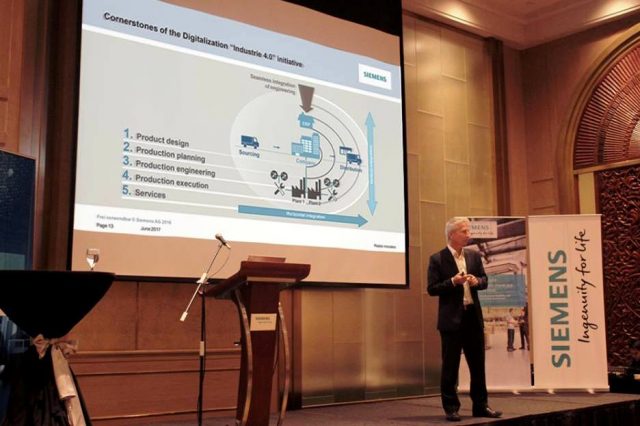
MANILA, PHILIPPINES — Siemens AG, the global technology powerhouse based in Germany, recently unveiled its latest agenda for the local industry in a day-long event entitled “Discover the Potential of Digitalization in Food and Beverage Industry” held at the Dusit Hotel in Makati.
A major part of the event was the launch of Siemens’ Digital Factory innovation platform which enables manufacturing companies to streamline and digitalize their entire business process. It links the virtual and real production worlds through the simulation of machines and plants using Siemens’ expanded product portfolio for the Digital Enterprise.
Interaksyon sat down with Roland Heymann, head of Technical Account, Food & Beverage, Digital Factory Division, Siemens AG, and Enrico Buergo, VP and Country Division lead, Digital Factory/Process Industries, Siemens Phils., for an exclusive peek at Siemens’ Digital Factory.
Interaksyon (INT): What’s the digitalization event all about?
Siemens (SIE): Food and beverage is one of fastest growing consolidated industries Siemens is involved in worldwide and we combine our knowhow from our products basket to optimize industries. One of the concepts we have developed is the so-called digital factory and in today’s event, we look forward to sharing with local industries our learnings that we have put together with our corporate clients worldwide.
Our commitment with the Food & Beverage (F&B) market comes from its requirements for more agile production, more diverse products and faster delivery times for improved efficiency of operations. These are requirements that we align with our product basket for the digital factory and we would like to help the Philippine F&B leverage from what we’ve learned so far.
A major concern we would like to address is that of food waste. It is estimated that 30% of fresh food is being wasted due to limitations in the production process today. There is not enough knowhow in the supply chain and not enough agility or flexibility in the production environment to avoid so much wastage. We believe that with the digital factory, we can help to decrease the scale of unwanted waste.
INT: What constitutes the digital factory and is it specific only to the F&B market?
SIE: Siemens’ product portfolio has expanded broadly over the past couple of years and it covers the whole product development cycle from creating a product starting with the recipe to developing the necessary production machineries or process equipment as well in developing layout plans so the equipment and facilities will be efficiently working with the lowest energy consumption with the highest throughput at lowest possible level of waste.
This initiative has resulted in a number of products starting with basic things like automation controllers and network devices, and leading to software tools that help the factory manager simulate conditions and communicate with business IT systems. These are the foundation elements of “The Digital Factory”.
The digital factory however is not specific to the F&B industry. It is something that is generic. It arose from insights from different market segments and it is fair to state that there are other market segments that are advancing faster, that are a little more sophisticated when it comes to the use of modern technologies.
We can learn from the automotive segment, for instance, which we can carry over and have other industries benefit from these lessons. Our task now is to use a generic digital factory platform, break down the implementation to specific activities and make it work for the F&B industry.
INT: What specific gaps and problems in the local F&B industry will the digital factory address?
SIE: Our findings show that the industry needs across the board not just in the Philippines are: “We would like the process to be flexible. We would like it to be automatic and interactive that we won’t have errors when we create new products that we can introduce to the market on time.”
The reality however is different. The reality is being driven by ageing production facilities in the market, and by business models from a lot of individual machine-building companies, that lead to a very heterogeneous business environment.
One of the first steps we are seeing now is standardization where we can help clients significantly because we have the knowhow, we have a broad portfolio to do it, and we have successfully implemented it a number of times. We continue to have fruitful discussions with customers who appreciate that a homogenous environment is the first milestone in the digitalization journey.
Then we talk about reintegration, the need to bring the data up to the standard set. We can provide the expertise to take them to the next step. We follow our roadmap to arrive at the digital factory.
INT: Key industry players have been invited to today’s event on digitalization for the F&B segment. What are your expectations?
SIE: Our expectations are to keep the customers satisfied, give value to them with this event and make them think when they come back to their workplace that their concerns regarding how they want to operate, how to have an efficient plant, have somehow been addressed.
At the same time, we want to create a digital mindset. We want to start this conversation about industry digitalization. We want to create a community that really looks at digitalization as the way to go — that if you don’t take the journey, you might be left out.









